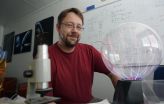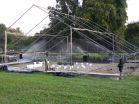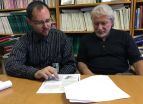Experiments in the realm of the impossible
Physicists of Jena University, Germany simulate for the first time charged Majorana particles -- elementary particles, which are not supposed to exist
2015-05-27
(Press-News.org) Jena (Germany) March 1938: The Italian elementary particle physicist Ettore Majorana boarded a post ship in Naples, heading for Palermo. But he either never arrives there - or he leaves the city straight away - ever since that day there has been no trace of the exceptional scientist and until today his mysterious disappearance remains unresolved. Since then, Majorana, a pupil of the Nobel Prize winner Enrico Fermi, has more or less been forgotten. What the scientific world does remember though is a theory about nuclear forces, which he developed, and a very particular elementary particle.
"This particle named after Majorana, the so-called Majoranon, has some amazing characteristics", the physicist Professor Dr. Alexander Szameit of the Friedrich Schiller University Jena says. "Characteristics which are not supposed to be existent in our real world." Majorana particles are, for instance, their own antiparticles: Internally they combine completely opposing characteristics - like opposing charges and spins. If they were to exist, they would extinguish themselves immediately. "Therefore, Majoranons are of an entirely theoretical nature and cannot be measured in experiments."
Together with colleagues from Austria, India, and Singapore, Alexander Szameit and his team succeeded in realizing the impossible. In the new edition of the science magazine 'Optica' they explain their approach: Szameit and his team developed a photonic set-up that consists of complex waveguide circuits engraved in a glass chip, which enables them to simulate charged Majorana particles and, thus, allows to conduct physical experiments (doi: 10.1364/OPTICA.2.000454).
"At the same time we send two rays of light through parallel running waveguide lattices, which show the opposing characteristics separately," explains Dr. Robert Keil, the first author of the study. After evolution through the lattices, the two waves interfere and form an optical Majoranon, which can be measured as a light distribution. Thus, the scientists create an image that catches this effect like a photograph - in this case the state of a Majoranon at a defined moment in time. "With the help of many of such single images the particles can be observed like in a film and their behaviour can be analyzed," says Keil.
This model allows the Jena scientists to enter completely unknown scientific territory, as Alexander Szameit stresses. "Now, it is possible for us to gain access to phenomena that so far only have been described in exotic theories." With the help of this system, one can conduct experiments in which conservation of charge - one of the pillars of modern physics - can easily be suspended. "Our results show that one can simulate non-physical processes in a laboratory and, thus, can make practical use of exotic characteristics of particles that are impossible to observe in nature." Szameit foresees one particular promising application of simulated Majoranons in a new generation of quantum computers. "With this approach, much higher computing capacities than are possible at the moment can be achieved."
INFORMATION:
Original Publication:
Keil R. et al. Optical simulation of charge conservation violation and Majorana dynamics. Optica, Vol. 2, Issue 5, pp. 454-459 (2015), doi: 10.1364/OPTICA.2.000454
Contact:
Prof. Dr. Alexander Szameit
Institute of Applied Physics
Friedrich Schiller University Jena
Albert-Einstein-Strasse 15, 07745 Jena
Germany
Phone: ++49 3641 947985
Email: alexander.szameit@uni-jena.de
[Attachments] See images for this press release:

ELSE PRESS RELEASES FROM THIS DATE:
2015-05-27
Hodgkin's lymphoma--cancer of the lymph nodes--arises in more than 150 children and adolescents in Germany each year. Nine out of ten patients survive the disease, thanks to the highly effective treatments that are now available. Depending on the type of treatment given, however, there may be late sequelae, as discussed by Wolfgang Dörffel and colleagues in an original article in the current issue of Deutsches Ärzteblatt International (Dtsch Arztebl Int 2015; 112: 320-7). These authors studied the question of which types of treatment were more likely to be followed ...
2015-05-27
An international team of researchers has for the first time predicted the occurrence of aurorae visible to the naked eye on a planet other than Earth.
Mars' upper atmosphere may be indeed closer to Earth's than previously thought. Researchers showed that the upper atmosphere of Mars glows blue depending on the activity of the Sun. The result was achieved through numerical simulation and a laboratory experiment, called the Planeterrella, used to simulate the aurora. The study was published in the leading planetology publication Planetary and Space Science on 26 May.
'The ...
2015-05-27
GAINESVILLE, FL -- As the container nursery industry faces severe restrictions on water use, researchers are looking to identify ways to minimize watering needs and eliminate excess watering. The authors of a new study say that understanding container-grown plants' capacity to "capture" sprinkler irrigation water can give growers important tools that help them adjust irrigation rates, reduce water use, and produce healthy plants.
Jeff Million and Thomas Yeager from the Department of Environmental Horticulture at the University of Florida say that there has been limited ...
2015-05-27
Brisbane flood victims suffered more psychological distress during the rebuilding phase than as waters inundated their homes and businesses, a Queensland University of Technology study has found.
Kelly Dixon, from QUT's School of Psychology and Counselling, has looked at the mental health impacts caused by the Brisbane 2011 and the Mackay 2008 flood disasters.
"The findings showed that aftermath stress contributed to poor mental health outcomes over and above the flood itself, prior mental health issues and demographic factors," Ms Dixon said.
Presenting her findings ...
2015-05-27
In a groundbreaking study published recently in the Journal Psychology, Professor Lea Waters from the Melbourne Graduate School of Education outlines how children can draw on their personal strengths to cope with the demands that lead to stress.
"While some stress such as toxic stress caused by a long lasting intense negative experience can have a debilitating effect on the wellbeing of children, not all stress is bad or damaging," Professor Waters said.
"Positive stress is a normal part of the developmental process. When managed well, it has the potential to help children ...
2015-05-27
Warring armies use a variety of tactics as they struggle to gain the upper hand. Among their tricks is to attack with a decoy force that occupies the defenders while an unseen force launches a separate attack that the defenders fail to notice.
A study published earlier this month in the journal Proceedings of the National Academy of Sciences suggests that the Hepatitis C virus (HCV) may employ similar tactics to distract the body's natural defenses. After infecting patients, Hepatitis C evolves many variants, among them an "altruistic" group of viral particles that appears ...
2015-05-27
Millions of genetic variants have been discovered over the last 25 years, but interpreting the clinical impact of the differences in a person's genome remains a major bottleneck in genomic medicine. In a paper published in The New England Journal of Medicine on May 27, a consortium including investigators from Brigham and Women's Hospital (BWH) and Partners HealthCare present ClinGen, a program to evaluate the clinical relevance of genetic variants for use in precision medicine and research.
"We're dealing with massive amounts of information: more than 80 million genetic ...
2015-05-27
Tremendous advances have been made in decoding the human genome in recent years but critical questions remain regarding what these variants mean and how they can be applied in clinical practice. In a comprehensive paper to be published in The New England Journal of Medicine on May 27, 2015, "ClinGen: The Clinical Genome Resource," a consortium including investigators from the American College of Medical Genetics and Genomics (ACMG) provide a detailed overview of ClinGen, an NIH-supported program to evaluate the clinical relevance of genetic variants for use in precision ...
2015-05-27
Women who eat a Mediterranean diet could cut their risk of womb cancer by more than half (57 per cent), according to a study published today (Wednesday) in the British Journal of Cancer*.
The Italian researchers looked at the diets of over 5,000 Italian women to see how closely they stuck to a Mediterranean diet and whether they went on to develop womb cancer**.
The team broke the Mediterranean diet down into nine different components and measured how closely women stuck to them. The diet includes eating lots of vegetables, fruits and nuts, pulses, cereals and potatoes, ...
2015-05-27
If greenhouse-gas emissions continue to rise, glaciers in the Everest region of the Himalayas could experience dramatic change in the decades to come. A team of researchers in Nepal, France and the Netherlands have found Everest glaciers could be very sensitive to future warming, and that sustained ice loss through the 21st century is likely. The research is published today (27 May) in The Cryosphere, an open access journal of the European Geosciences Union (EGU).
"The signal of future glacier change in the region is clear: continued and possibly accelerated mass loss ...
LAST 30 PRESS RELEASES:
[Press-News.org] Experiments in the realm of the impossible
Physicists of Jena University, Germany simulate for the first time charged Majorana particles -- elementary particles, which are not supposed to exist



